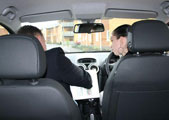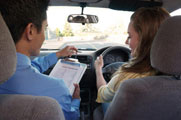
Driving Tests
In order to get your driving licence you must first pass a two - part Theory Test and a Practical Test
The Theory Test - Multiple Choice
The Theory Test has been developed to focus new drivers on knowing how to be safe on the roads. The test is a series of multiple choice questions that test the student’s ability to identify hazards on the road and how to avoid them.
You must bring along your provisional driving licence and some other acceptable proof of identity that bears your name, photograph and signature.
The questions vary between straight text; text with graphics of road signs; and text with photographs of road and driving scenarios. Most will require one option to be selected from a choice of four, some will ask for two, three, or four correct options to be selected from a range of up to six possibilities.
Tests are written at the local Theory Test centre. However you will not be the only one taking the test, as up to 30 candidates will be in the test centre. Candidates sitting the driving theory test select their answers by simply touching a computer screen instead of marking answers on a test paper. This Touchscreen system has been carefully designed to make sure it is easy to use.
Candidates can work through a practice session lasting up to 15 minutes to get used to the system before starting their actual test. Staff at the test centres will be on hand to help candidates who have any difficulties in using the new system.
The screens are easy to read. Only one question will appear on the screen at one time, and candidates will be able to move backwards and forwards through the questions. Candidates will also be able to go back to any questions which they want to look at again and it will be easy to change any answers. The system will also alert candidates if they have not completely answered a question.
Things to Remember:
- The test questions will not change in any way. Candidates will have 40 minutes to answer 50 test questions
- The pass mark will remain at 43 questions correctly answered
- All candidates will receive their test results before they leave the test centre
- You do not have to pass the Theory Test before you can begin driving lessons
The Hazard Perception Test (HPT)
The Hazard Perception Test is the second part of the driving theory test. After you finish the multiple - choice section (the actual theory test) you will be permitted a break of up to 3 minutes. A short tutorial video on the hazard perception test will then play, once finished the hazard perception test will begin. The test will take about an extra 15 minutes.
The object is to identify up to 15 hazards as quickly as possible from 14 video clips, and you will have to pass this before being able to sit the practical test.
How the Hazard Perception Test works
The hazard perception part of your test is delivered on a computer and you respond by clicking a button on the mouse. You will be presented with a series of video clips which feature every day road scenes. In each clip there will be at least one developing hazard, but one of the clips will feature two developing hazards.
To achieve a high score you will need to respond to the developing hazard during the early part of its development. The maximum you can score on each hazard is five.
An example of when to respond
As an example of how to identify and respond to a developing hazard, consider a parked vehicle on the side of the road. When you first see it, it’s not doing anything; it’s just a parked vehicle. If you were to respond to the vehicle at this point, you would not score any marks, but you would not lose any marks.
However, when you get closer to the vehicle, you notice that the car’s right hand indicator starts to flash. The indicator would lead you to believe that the driver of the vehicle has an intention of moving away, therefore the hazard is now developing and a response at this point would score marks. The indicator coming on is a sign that the parked vehicle has changed its status from a potential hazard into a developing hazard.
When you get closer to the vehicle you will probably see the vehicle start to move away from the side of the road; another response should be made at this point. Different clips in the test will have various signs to indicate that the hazard is changing its status and is now starting to develop.
How the Test is scored
The maximum you can score for each developing hazard is five points. You should respond by pressing the mouse button as soon as you see a hazard developing that may result in you, the driver, having to take some action, such as changing speed or direction. The earlier you notice a developing hazard and make a response, the higher your score.
You won't be able to review your answers to the hazard perception test; as on the road, you will only have one chance to respond to the developing hazard, so you will need to concentrate throughout each clip.
If you react inappropriately during the video clip by clicking continuously or in a pattern of responses you will score zero for that clip. At the end of the clip a pop - up box will appear informing you that you have scored zero for that particular clip.
Pass Rate
To pass the hazard perception test you must score at least 44 points out of a possible 75.
FACT: A high number of new drivers are involved in accidents, especially in the first months after passing a driving test. It has been proven that drivers who have taken hazard perception training have much better hazard perception skills than those who haven’t.
The Practical Driving Test
We will book your test for you. A test date and time will be given, which may be changed if it’s unsuitable. You must give a least 14 working days notice to cancel your test.
The Practical Driving Test usually lasts about 45 minutes and will be taken at your local driving test centre by a DSA examiner. You will be examined on your ability to drive competently and safely by an examiner sitting in the car with you. You will use our car so you are fully familiar with the controls as candidates need to be as confident and relaxed as possible during the examination.
During your lessons you will be taught what to expect in the test. The examiner will inform you whether you've passed or not after the test, should you fail you will be told what you did wrong. You can re - apply for another test straight away, but you must wait at least 10 working days before your next test. If you pass your test you will be given a form to apply for your Full Driving Licence.
For latest pricing information please visit www.dsa.gov.uk





